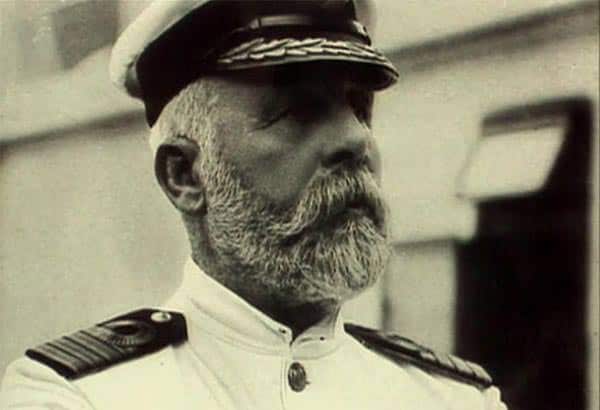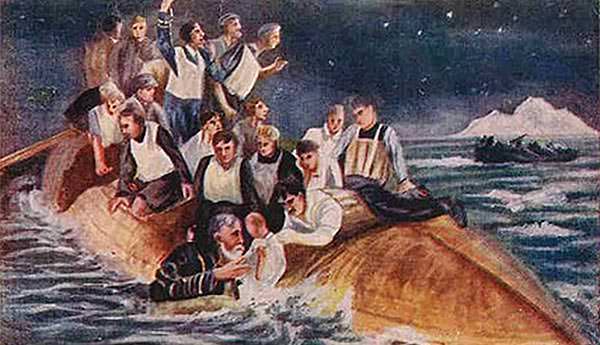Jump to the story of the Titanic Captain
Edward John Smith
27 January 1850 – 15 April 1912
Although an experienced and long-serving skipper at the time he served as Captain of the Titanic, today – as then – there are mixed opinions on his performance in charge of the great ship. Smith’s judgement, decision-making, and his culpability (or otherwise) are still debated today. Here we present the key facts about the life and career of Captain Smith, and leave it to the reader to judge whether he was a hero or not.

Above: Titanic Captain Edward John Smith.
Early Life
27 January 1850 – the date of Captain Smith’s birth, in Hanley, Stoke-on-Trent, England.
86 Well Street – the address in Hanley where Edward was born (note: the house number is often, and wrongly, quoted as 51; this is a misreading of a reference to the 1851 census, within which Smith first appears).
07 October 1864 – the date on which Smith’s father, Edward senior, died at home. Aged 59, he had finally succumbed to the phthisis (a form of pulmonary tuberculosis) from which he had been suffering for some time.
11 October 1864 – date Smith’s father was buried, at Hanley municipal cemetery (in nearby Shelton).
1864 – the approximate year (exact date unknown) that Edward left Etruria British School and started work at Etruria Forge (this event may have been triggered by the death of his father).
14 – the approximate age at which Smith left school to work at the forge.
Did You Know?
Smith was a capable worker and whilst still in his teens was trained to operate a huge Nasmyth hydraulic steam hammer, making large wrought-iron components for ships.
Career At Sea
17 – the age at which Smith left the forge, possibly motivated by declining demand in the iron industry, and travelled to Liverpool to look for new opportunities working at sea.
Did You Know?
Smith was following in the footsteps of his half-brother Joseph Hancock, who had gone to sea sometime in late 1849, early 1850. By the time Smith went to sea Joseph had risen to the rank of Captain.
05 February 1867 – the date on which Smith arrived in the city of Liverpool, travelling with friends and seeking work in the merchant navy. Smith signed up as an apprentice ship’s ‘Boy’ (the lowest rank of ordinary seaman) on an American packet ship, the Senator Webber, under the captaincy of his half-brother Joseph.
12 February 1867 – the date on which Smith’s first journey to sea began, a return trip to Hong Kong, then a busy and exotic international port, full of European, American, Australian and Asian shipping, and part of the British empire.
26 – the number of men and boys serving aboard the Senator Webber.
6 months – the length of the outward journey to Hong Kong, the Senator Webber arriving in August 1867.
200 – the approximate number of different ropes and their uses that Smith would have been required to learn, and quickly, an education that all sailors went through and giving the English language the idiom “knowing the ropes”. This was just one area to learn, others including setting the sails, wind and weather, the intricacies of navigation, an understanding of draft and displacement, and learning how to load a ship to ensure an “even keel”.
1871 – the year Smith was awarded a certificate of competency as Second Mate.
1873 – the year Smith gained his certificate as First Mate.
1875 – the year that Smith gained his Masters Certificate, allowing him to command vessels.
24 – the age at which Smith gained his Masters Certificate.
Did You Know?
Edward was often referred to as ‘E.J.’ by his crew-mates. This may have started during his first-ever voyage, upon the Senator Webber, on which there were two Edward Smiths serving in the crew.
1877 – the year Smith first took command of a ship, the 1,000-ton trade vessel Lizzie Fennell, running goods between Britain and South America.
26 – the age at which Smith took command of the Lizzie Fennell, much younger than the average age that men typically gained a captaincy, which was then closer to 40.
1880 – the year Smith joined the White Star Line, the company he would stay with for the rest of his life, and served on his first passenger vessel, as fourth officer aboard the liner SS Celtic.
Did You Know?
In joining White Star Line Smith moved down a number of ranks, going from Captain to a junior officer position, but was happy to do so in order to gain the opportunity to serve on the larger, finer and more prestigious ships of the North Atlantic passenger crossings.
1882 – the year that Smith was promoted to second officer of the SS Coptic.
1885 – the year that Smith became first officer of the SS Republic I.
1887 – the year that Captain Smith took command of the SS Republic I.
37 – the age at which Smith captained this ship, the first passenger vessel he commanded both for White Star Line and in his career.
1888 – the year Captain Smith was awarded his Extra Master Mariner’s Certificate.
Did You Know?
Captain Smith initially failed the examination for his Extra Master Mariner’s Certificate, on his navigational skills. He was re-tested the following week and this time he passed.
1888 – the year Captain Smith joined the Royal Naval Reserve, meaning that he could be called upon to serve in the Royal Navy during wartime, and could add the letters ‘RNR’ after his name.
18 – the number of White Star Line vessels commanded during his career.
In all my experience, I have never been in any accident of any sort worth speaking about. I never saw a wreck and never have been wrecked, nor was I ever in any predicament that threatened to end in disaster of any sort. -Captain Smith, speaking 5 years before the Titanic disaster
43 – the number of years of experience at sea at the time Smith took command of Titanic.
32 – the number of years served with the White Star Line.
Did the Captain of the Titanic die?
Captain Smith did indeed perish when the Titanic sank. Some survivors reported seeing him inside the wheelhouse of the bridge as Titanic sank, whilst others claim to have seen Smith commit suicide using a pistol. No reliable account exists, however.
26 – the number of years of experience Captain Smith had gained in traveling the North Atlantic at the time he captained the Titanic.

Above: The Titanic Captain Edward John Smith, depicted saving a child from the water, from a postcard published in 1912. This version of events is just one of many accounts from survivors (see ‘Did the captain of the Titanic die?’ above).
£200 – the annual bonus available to Captain Smith ‘if no ship under his command was involved in an incident’.
£16,000 – the approximate value of the bonus in current money [?].
Well boys, do your best for the women and children, and look out for yourselves. -The possible last words of Captain Smith, Commander of Titanic, as witnessed by Ship Steward Brown
15 April 1912 – the date of Captain Smith’s death (he died when the ship sank).
62 – Smith’s age at the time of his death. Some believe he intended to retire after completing Titanic’s return trip, although the White Star Line had plans for Smith to command Gigantic on her maiden voyage.
Family Life
13 January 1887 – the date of Smith’s marriage to Sarah Eleanor Pennington, a farmer’s daughter from Winwick in Cheshire, at St Oswald’s Church in the village.
02 April 1898 – the date their daughter was born, Helen Melville Smith (Helen was born in Waterloo, Liverpool although the Smiths were then living in Southampton). Helen was the couples’ only child.
Did You Know?
Eleanor referred to her husband as ‘Teddy’ whilst he, through his correspondence whilst away at sea, referred to her as ‘my only dear one’.
1908 – the year Smith moved to Southampton, after almost 40 years spent living (when not at sea) in Waterloo, near Liverpool.
28 April 1931 – the date on which Eleanor Smith died. Knocked down by a taxi cab in Cromwell Road, London, she suffered a fractured skull and passed away in St Mary Abbot’s Hospital a little later. She was buried in the same grave as Captain Smith.
69 – Eleanor’s age at death.
19 – the number of years that Eleanor lived as a widow, never remarrying.
Legacy and Memorial
15 November 1912 – the date on which Captain Smith’s will was issued, in London, the sole beneficiary being his widow Eleanor.
£3,186 – the value of Captain Smith’s effects (more accurately, £3,186, 4s, 6d).
£190-250,000 – the equivalent value of Smith’s estate in 2016 money [?].
29 July 1914 – a bronze memorial statue of Captain Smith is unveiled in Beacon Park, Lichfield (the memorial was sculpted by Kathleen Scott, the wife of the Antarctic explorer Captain Robert Falcon Scott).
£740 – the original cost of the memorial.
The Story of the Titanic Captain
Captain Edward John Smith’s life, marked by triumphs and tragedies, exemplifies the spirit of exploration and dedication that defined the era of great maritime voyages. From his humble beginnings in Stoke-on-Trent to his final voyage on the Titanic, Smith’s journey is a poignant reminder of the human stories behind historical events.
Born on 27 January 1850 in Hanley, Stoke-on-Trent, England, Edward John Smith grew up in a modest household at 86 Well Street. Tragedy struck early in his life when, on 07 October 1864, his father, Edward Smith Senior, succumbed to phthisis, a form of pulmonary tuberculosis. The loss of his father deeply impacted the young Edward, who was just 14 years old at the time. His father’s burial took place on 11 October 1864, at Hanley’s municipal cemetery in nearby Shelton.
Beginning of a maritime career
In the wake of his father’s death, Smith left Etruria British School around 1864 to work at Etruria Forge, learning to operate a Nasmyth hydraulic steam hammer, which coincidentally played a crucial role in shipbuilding.
At the age of 17, Smith left the forge, possibly influenced by the declining demand in the iron industry. He journeyed to Liverpool, seeking new horizons at sea, and thereby following in the footsteps of his half-brother Joseph Hancock, who had already established himself as a sea captain.
Smith’s apprenticeship and early voyages
Upon arriving in Liverpool on 05 February 1867, Smith embarked on his nautical journey. He signed up as an apprentice, taking the humble position of a ship’s ‘Boy’ on the Senator Webber, captained by his half-brother Joseph. His first voyage commenced on 12 February 1867, marking the start of an illustrious career at sea.
Education at sea and rising through the ranks
During his early years at sea, Smith learned the intricacies of sailing, including the functions of approximately 200 different ropes – a knowledge that contributed to the English idiom “knowing the ropes”. His education encompassed various areas: setting sails, understanding wind and weather, mastering navigation, and learning the principles of draft and displacement. By 1871, Smith had earned his certificate of competency as Second Mate, followed by his First Mate certificate in 1873. In 1875, at the age of 24, he achieved his Master’s Certificate, allowing him to command vessels.
Ascending to captaincy
Smith’s first command came in 1877 with the Lizzie Fennell, a 1,000-ton trade vessel. At 26, he was significantly younger than most men who reached captaincy, typically around 40. His career took a significant turn in 1880 when he joined the White Star Line, starting as a fourth officer on the SS Celtic. This move, though initially a step down in rank, was a strategic choice to serve on larger and more prestigious North Atlantic passenger ships.
Promotions and accomplishments
Smith’s proficiency and leadership skills led to a series of promotions within the White Star Line. He became the second officer of the SS Coptic in 1882, the first officer of the SS Republic I in 1885, and eventually captained the same ship in 1887. By the age of 37, he had captained his first passenger vessel for both the White Star Line and in his career.
In 1888, Smith was awarded his Extra Master Mariner’s Certificate, despite initially failing the examination on navigational skills. He retook the test a week later and passed.
Service in the Royal Naval Reserve
In the same year, 1888, Smith joined the Royal Naval Reserve, a commitment that meant he could be called to serve in the Royal Navy during wartime. This affiliation allowed him to append ‘RNR’ after his name, signifying his readiness to serve his country in times of need.
Commanding the Titanic
By the time he took command of the Titanic, Smith had amassed 43 years of experience at sea, including 32 years with the White Star Line and 26 years navigating the North Atlantic. His reputation as a skilled and experienced captain was further enhanced by the annual bonus of £200 he received for maintaining a record of no incidents under his command.
Personal life and legacy
Smith married Sarah Eleanor Pennington on 13 January 1887. The couple welcomed their daughter, Helen Melville Smith, on 02 April 1898. Despite his demanding career, Smith maintained a loving relationship with his family, often referring to his wife affectionately in his correspondence while at sea.
The family moved to Southampton in 1908, marking the end of nearly four decades of living in Waterloo, near Liverpool. Tragically, Smith perished on 15 April 1912, at the age of 62, during the sinking of the Titanic. It was speculated that he intended to retire after the Titanic’s return trip, though the White Star Line had plans for him to command the Gigantic on her maiden voyage.
Smith’s enduring legacy
Smith’s widow, Eleanor, lived 19 years as a widow, never remarrying, and died at the age of 69. The couple’s shared legacy continued through their daughter, Helen, and the enduring impact of Smith’s maritime career. His will, issued on 15 November 1912, left an estate valued at approximately £3,186, equivalent to more than £300,000 in modern money.
On 29 July 1914, a bronze memorial statue of Captain Smith was unveiled in Beacon Park, Lichfield, commemorating his life and contributions to maritime history. The statue, crafted by Kathleen Scott, wife of Antarctic explorer Captain Robert Falcon Scott, stands as a testament to Smith’s enduring legacy.
More To Explore
If you have found these facts about the Titanic Captain interesting, why not read about the crew of the Titanic, about the ill-fated maiden voyage, and about the sinking of the ship.
